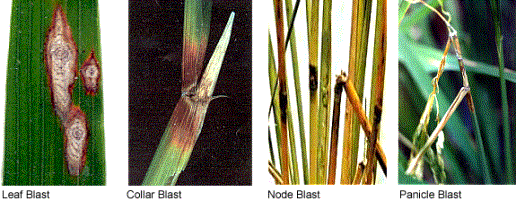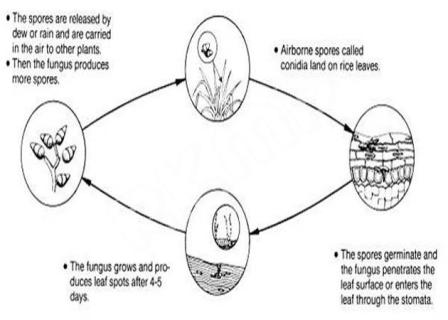Blast of Paddy Host: Oryza sativa Systematic Position Pathogen: P.oryza Division:Eumycota Sub-division:Deuteromycotina Class:Hyphomycetes Order:Moniliales Family:Moniliaceae Genus:Pyricularia Species:oryzae Introduction It is the earliest plant disease known and was first recorded in China in 1637 in A.D. In India it was first reported in Tanjore district of Tamilnadu in 1913. It occurs in all areas of the world leading to a loss in yield up to 70-80%. Symptoms · The fungus attacks all the aerial parts of the plant, majorly leaves and panicle are infected. · Small brown flecks are formed on leaves later enlarges into spindle shaped spots with pointed ends known as lesions. · The central portion of the lesion is pale green (or) dull grayish green colour but in older spots they become grey (or) straw coloured. · The lesions also present on the other parts like leaf sheaths, nodes, rachis and culms. · The pathogen infects the leaf in young stage which is known as leaf blast. · The neck of the panicle is infected at the time of ear emergence and produces brown necrotic lesions which turn black causing neck rot. This phase is known as neck blast (or) black neck (or) black neck (or) rotten neck. · The affected parts can be identified by the presence of bluish patches on the stems.
Casual Organism/Pathogen The fungus Pyricularia oryza causes blast disease of paddy by releasing a toxin Pyricularin. Fungal Structure The mycelium of fungus is septate,branched hyphae, hyaline to olivaceous colour and uninulcleate.The hyphae grows intercellular producing conidiophores with spores conidia usually present at the terminal part, 3 celled(2septate) and uninucleate. Disease Cycle The pathogen survives as mycelium, conidia, and seeds and on weeds. The alternative hosts are Panicum repens, Digitaria marginata, Leersia hexandra etc. The primary infection takes place through conidial spores present in the alternative hosts. These spores are carried by wind and falls on the moist leafs leading to secondary infection. In absence main host they will survives in the soil as chlamydospores and survives in the alternative host.   Disease Cycle Favorable Conditions · High nitrogen fertilizers. · Prolonged leaf wetness. · High humidity i.e., 90%. · Optimum temp. i.e., 20⁰c.
Control Measures · Using of disease resistant varieties. · Changing the crop frequently. · Field sanitation. · Using fungicides o Copper fungicides: Mancozeb. o Mercuric fungicides: Agrosan Gn. o Systemic fungicides: Pyroquilon, Tricyclazone ceresan. o Organophosphates: Benzomyl thiophnate methyl. o Antibiotics:Cephalothecin,Antimycin,Antiblastin and Blastimycin
| 




